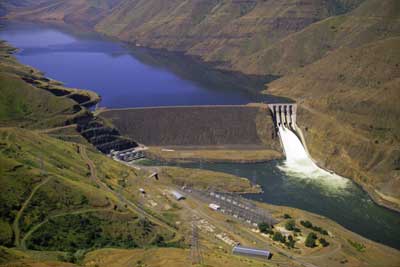forum
library
tutorial
contact

EPA Questions Utility's River Plan
by Rocky BarkerIdaho Statesman, July 12, 2009
|
the film forum library tutorial contact |

|
EPA Questions Utility's River Plan
by Rocky BarkerIdaho Statesman, July 12, 2009 |
 Most autumns, the Snake River is too warm for the chinook salmon and steelhead that spawn there.
Most autumns, the Snake River is too warm for the chinook salmon and steelhead that spawn there.
Development has stripped shade from miles of riverbanks. Farmers, industry and others tap tributaries up and down the river, cutting flows and making the river slower and shallower.
And the dams that provide much of Idaho Power Co.'s electrical supply hold the river still at Brownlee, Oxbow and Hells Canyon, leaving the water far more susceptible to warming by the high desert's hot summer sun.
The Endangered Species Act requires the region to do something about this, and the Environmental Protection Agency wants Idaho Power to make it happen. The company has to find a way to reduce temperatures below the Hells Canyon dams before it can get a new 30-year license to run the dams' power plants.
The utility proposes that it spend $3 million a year - up to $120 million over 40 years - to restore trees to shade the Snake's upstream tributaries, to raise flows and to undertake other measures that would cool the river before it ever gets to Hells Canyon.
The company says this will bring the water to the federal standard of 55.3 degrees below the dams, where endangered fall chinook salmon and steelhead spawn.
But the EPA doubts that the water will stay cool throughout the 100-mile journey through the Snake and its reservoirs to get past Hells Canyon.
"Right now it's very unclear what these projects are going to be and that they would represent any temperature benefits downstream," said John Palmer, an EPA senior policy advisor who wrote a letter to Idaho Power expressing the agency's doubts. "We think to get the level of temperature reduction it would require a significant amount of restoration."
The possible solution? Force the company to pay up to $250 million for a structure that chills the Brownlee Reservoir by churning cooler water up from the bottom of the reservoir and pumping it out past the dam.
Idaho Power says it exceeds federal water quality standards only during a two-week period in October - a view EPA disputes. The company opposes spending so much for a temperature control structure needed for such a short time.
"It's really addressing a symptom instead of the cause," said Idaho Power attorney Jim Tucker. That's why the company - and at least some federal and state officials - support the broader plan to make changes up and down the watershed.
The dispute is the last major issue holding up Idaho Power's nearly 15-year effort to obtain a new license to operate Brownlee, Oxbow and Hells Canyon dams. It has cost $107 million so far. In 2004, the company estimated the process and its requirements would cost more than $325 million over 30 years.
That would increase the power bills of the nearly 500,000 Treasure Valley and other southern Idaho and eastern Oregon customers.
WHO DECIDES?
The EPA doesn't have a direct role in the certification.
The Federal Energy Regulatory Commission is charged with balancing Idaho Power's private interests and the public's, and right now, that agency is waiting to see if Idaho and Oregon certify that the projects meet water quality standards.
Only if the state of Washington voluntarily decides the dams will violate these standards will the EPA get involved.
Both Idaho and Oregon like the company's approach to cool the river throughout the watershed because it brings lower temperatures and improved water quality to a larger area. But they are waiting for Idaho Power to complete new studies, expected by August, before making a decision.
"I'm cautiously optimistic," said Paul DeVito, natural resource specialist for the Oregon Department of Environmental Quality.
Idaho Power has another powerful ally in the National Marine Fisheries Service, the agency in charge of restoring endangered Snake River fall chinook.
The spawning habitat of 80 percent of the river's fall chinook was cut off when the dams were built, destroying a resource that was sacred to Indian tribes and prized by sportsmen. The chinook returned to the Boise River until the dams were built in the 1950s.
"We have indicated to EPA and to the state agencies that we have a preference for the watershed approach to temperature control structure because it sets the stage for future reintroduction (of chinook) should we get water quality sufficient to allow it," said Rich Domingue, a NMFS hydrologist in Portland who will be in charge of writing an opinion on how the dams affect salmon once the states have certified the plans.
If NMFS determines the dams won't jeopardize the salmon or offers alternatives that Idaho Power accepts, then FERC will make its final decision about the license.
Right now, the earliest that decision could come is in 2011.
learn more on topics covered in the film
see the video
read the script
learn the songs
discussion forum
